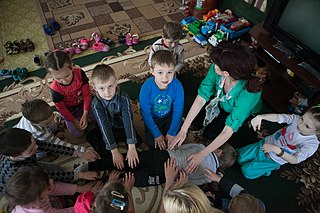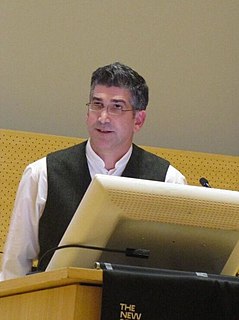Psychoanalysis is a set of theories and therapeutic techniques that deal in part with the unconscious mind, and which together form a method of treatment for mental disorders. The discipline was established in the early 1890s by Austrian neurologist Sigmund Freud, who developed the practice from his theoretical model of personality organization and development, psychoanalytic theory. Freud's work stems partly from the clinical work of Josef Breuer and others. Psychoanalysis was later developed in different directions, mostly by students of Freud, such as Alfred Adler and his collaborator, Carl Gustav Jung, as well as by neo-Freudian thinkers, such as Erich Fromm, Karen Horney, and Harry Stack Sullivan.

Psychotherapy is the use of psychological methods, particularly when based on regular personal interaction, to help a person change behavior, increase happiness, and overcome problems. Psychotherapy aims to improve an individual's well-being and mental health, to resolve or mitigate troublesome behaviors, beliefs, compulsions, thoughts, or emotions, and to improve relationships and social skills. Numerous types of psychotherapy have been designed either for individual adults, families, or children and adolescents. Certain types of psychotherapy are considered evidence-based for treating some diagnosed mental disorders; other types have been criticized as pseudoscience.
Integrative psychotherapy is the integration of elements from different schools of psychotherapy in the treatment of a client. Integrative psychotherapy may also refer to the psychotherapeutic process of integrating the personality: uniting the "affective, cognitive, behavioral, and physiological systems within a person".

Psychodynamic psychotherapy or psychoanalytic psychotherapy is a form of psychoanalysis and/or depth psychology, the primary focus of which is to reveal the unconscious content of a client's psyche in an effort to alleviate psychic tension, which is inner conflict within the mind that was created in a situation of extreme stress or emotional hardship, often in the state of distress. It evolved from and largely replaced psychoanalysis in the mid-20th century.
The Dodo bird verdict is a controversial topic in psychotherapy, referring to the claim that all empirically validated psychotherapies, regardless of their specific components, produce equivalent outcomes. It is named after the Dodo character in Alice in Wonderland. The conjecture was introduced by Saul Rosenzweig in 1936, drawing on imagery from Lewis Carroll's novel Alice's Adventures in Wonderland, but only came into prominence with the emergence of new research evidence in the 1970s.

Play therapy refers to a range of methods of capitalising on children's natural urge to explore and harnessing it to meet and respond to the developmental and later also their mental health needs. It is also used for forensic or psychological assessment purposes where the individual is too young or too traumatised to give a verbal account of adverse, abusive or potentially criminal circumstances in their life.
Resistance, in psychoanalysis, refers to oppositional behavior when an individual's unconscious defenses of the ego are threatened by an external source. Sigmund Freud, the founder of psychoanalytic theory, developed his concept of resistance as he worked with patients who suddenly developed uncooperative behaviors during sessions of talk therapy. He reasoned that an individual that is suffering from a psychological affliction, which Freud believed to be derived from the presence of suppressed illicit or unwanted thoughts, may inadvertently attempt to impede any attempt to confront a subconsciously perceived threat. This would be for the purpose of inhibiting the revelation of any repressed information from within the unconscious mind.
The therapeutic relationship refers to the relationship between a healthcare professional and a client or patient. It is the means by which a therapist and a client hope to engage with each other and effect beneficial change in the client.
Child psychotherapy, or mental health interventions for children have developed varied approaches over the last century. Two distinct historic pathways can be identified for present-day provision in Western Europe and in the United States: one through the Child Guidance Movement, the other stemming from adult psychiatry or psychological medicine, which evolved a separate child psychiatry specialism.
Psychoanalytic dream interpretation is a subdivision of dream interpretation as well as a subdivision of psychoanalysis pioneered by Sigmund Freud in the early twentieth century. Psychoanalytic dream interpretation is the process of explaining the meaning of the way the unconscious thoughts and emotions are processed in the mind during sleep.
Modern psychoanalysis is the term used by Hyman Spotnitz to describe the techniques he developed for the treatment of narcissistic disorders.
Common factors theory, a theory guiding some research in clinical psychology and counseling psychology, proposes that different approaches and evidence-based practices in psychotherapy and counseling share common factors that account for much of the effectiveness of a psychological treatment. This is in contrast to the view that the effectiveness of psychotherapy and counseling is best explained by specific or unique factors that are suited to treatment of particular problems. According to one review, "it is widely recognized that the debate between common and unique factors in psychotherapy represents a false dichotomy, and these factors must be integrated to maximize effectiveness". In other words, "therapists must engage in specific forms of therapy for common factors to have a medium through which to operate". Common factors is one route by which psychotherapy researchers have attempted to integrate psychotherapies.

Insight-oriented psychotherapy is a category of psychotherapies that rely on conversation between the therapist and the client. It involves developing the patient's understanding of past and present experiences, how they are related to each other and the effect they have on the patient's interpersonal relationships, emotions and symptoms. Insight-oriented psychotherapy can be an intensive process, wherein the client must spend multiple days per week with the therapist.
Joseph J. Sandler was a British psychoanalyst within the Anna Freud Grouping – now the Contemporary Freudians – of the British Psychoanalytical Society; and is perhaps best known for what has been called his 'silent revolution' in re-aligning the concepts of the object relations school within the framework of ego psychology.
Robert Joseph Langs was a psychiatrist, psychotherapist, and psychoanalyst. He was the author, co-author, or editor of more than forty books on psychotherapy and human psychology. Over the course of more than fifty years, Langs developed a revised version of psychoanalytic psychotherapy, currently known as the “adaptive paradigm”. This is a distinctive model of the mind, and particularly of the mind’s unconscious component, significantly different from other forms of psychoanalytic and psychodynamic psychotherapy.
Reality testing is the psychotherapeutic function by which the objective or real world and one's relationship to it are reflected on and evaluated by the observer. This process of distinguishing the internal world of thoughts and feelings from the external world is a technique commonly used in psychoanalysis and behavior therapy, and was originally devised by Sigmund Freud.

Jeremy David Safran was a Canadian-born American clinical psychologist, psychoanalyst, lecturer, and psychotherapy researcher. He was a professor of psychology at the New School for Social Research, where he served for many years as director of clinical training. He was also a faculty member at New York University's postdoctoral program in psychoanalysis and The Stephen A. Mitchell Center for Relational Studies. He was co-founder and co-chair of The Sandor Ferenczi Center at the New School for Social Research. In addition he was past-president of The International Association for Relational Psychoanalysis and Psychotherapy.
Accelerated experiential dynamic psychotherapy (AEDP) is an empirically validated mind-body psychotherapy that is informed by research in the areas of attachment theory, emotion theory, and neuroscience of change. This model of psychotherapy incorporates techniques from experiential therapies and ISTDP.
Diana Foșa is a Romanian-American psychologist, known for developing accelerated experiential dynamic psychotherapy (AEDP), an empirically validated psychotherapy, and for her work on the psychotherapy of adults suffering the effects of childhood attachment trauma and abuse.

John Christopher Muran is an American clinical psychologist and psychotherapy researcher.




